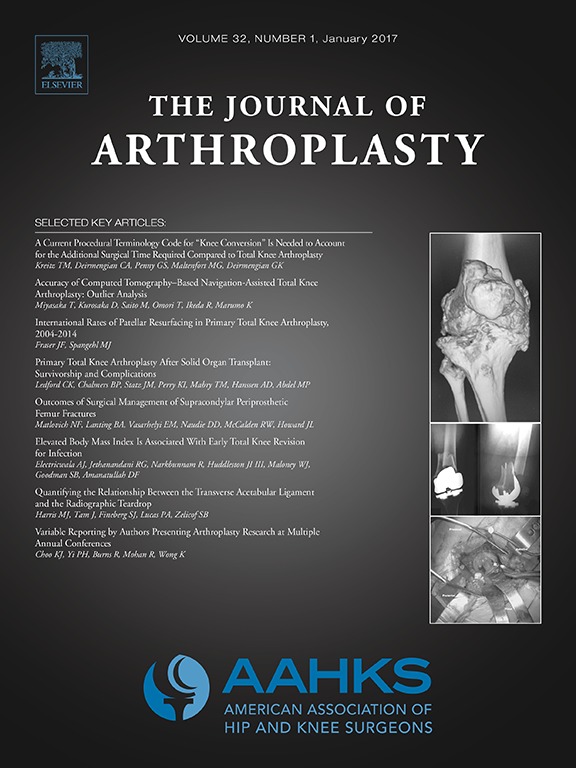
Similar Function and Adverse Events between THA and Hemiarthroplasty for Femoral Neck Fracture

Similar Function and Adverse Events between THA and Hemiarthroplasty for Femoral Neck Fracture
Hemiarthroplasty vs Total Hip Arthroplasty for the Management of Displaced Neck of Femur Fractures: A Systematic Review and Meta-Analysis
J Arthroplasty. 2019;(34)8:1837-1843.10.1016/j.arth.2019.03.070Synopsis
A meta-analysis of 17 studies (13 different trials), including randomized and prospective controlled trial was performed, with a total of 1364 patients. The outcomes of interest included mortality at 1 month, 1 year, and overall, infection, dislocation, revision, function (Harris Hip Score (HHS)) and Health-Related Quality of Life (HRQoL, based on Short-Form (SF)-36). Subgroup analyses were performed looking at unipolar vs. bipolar HA, mean age < or > than 80 years, and follow-up < or > 4 years. The included studies assigned patients to total hip arthroplasty (THA) versus hemairthroplasty (HA) for displaced femoral neck fractures (Garden III and Garden IV). Follow-up ranged from1 to 13 years. There was no difference in overall mortality, 30-day mortality, or 1-year mortality. There was also no difference between the two groups in in terms of infection, revision rate, function, or HRQoL. There was a significantly lower rate of dislocation in the HA group compared to THA (RR 0.37, p < 0.0001). The only finding that changed with subgroup analysis was that dislocation rate was only different in the first four years of follow-up, but not in studies with longer follow-up.
Were the search methods used to find evidence (original research) on the primary question or questions stated?
Was the search for evidence reasonably comprehensive?
Were the criteria used for deciding which studies to include in the overview reported?
Was the bias in the selection of studies avoided?
Were the criteria used for assessing the validity of the included studies reported?
Was the validity of all of the studies referred to in the text assessed with use of appropriate criteria (either in selecting the studies for inclusion or in analyzing the studies that were cited)?
Were the methods used to combine the findings of the relevant studies (to reach a conclusion) reported?
Were the findings of the relevant studies combined appropriately relative to the primary question that the overview addresses?
Were the conclusions made by the author or authors supported by the data and or analysis reported in the overview?
How would you rate the scientific quality of this evidence?
Yes = 1
Uncertain = 0.5
Not Relevant = 0
No = 0
The Reporting Criteria Assessment evaluates the transparency with which authors report the methodological and trial characteristics of the trial within the publication. The assessment is divided into five categories which are presented below.
4/4
Introduction
4/4
Accessing Data
3/4
Analysing Data
3/4
Results
4/4
Discussion
Detsky AS, Naylor CD, O'Rourke K, McGeer AJ, L'Abbé KA. J Clin Epidemiol. 1992;45:255-65
The Fragility Index is a tool that aids in the interpretation of significant findings, providing a measure of strength for a result. The Fragility Index represents the number of consecutive events that need to be added to a dichotomous outcome to make the finding no longer significant. A small number represents a weaker finding and a large number represents a stronger finding.
What was the principal research question?
In patients with displaced femoral neck fractures, does hemiarthroplasty, compared to total hip arthroplasty, result in any difference in functional outcomes, mortality, or other adverse events?
What were the important findings?
- There was no significant difference between total hip arthroplasty and hemiarthroplasty in terms of mortality at 1 month (THA: 5.2% vs. HA: 3.7%, p = 0.42), 1 year (THA: 13.3% vs. HA: 14.4% , p = 0.63), or final follow-up.
- There was no significant difference between THA and HA in terms of infection (THA: 2.5% vs. HA: 2.6%, p = 0.89) or revision (THA: 5.7% vs. HA: 8.8%, p = 0.05)
- There were no significant differences in terms of Harris Hip Score or Short-Form 36 scores
- There was a significant difference between the two groups in terms of dislocation rate (THA: 8.1% vs. HA: 2.67%, p = 0.0001)
- Subgroup analysis revealed no changes to the above findings for mean age > or < 80 years of age or bipolar vs unipolar HA
- Subgroup analysis revealed no significant difference in dislocation rate in studies with follow up > than 4 years
What should I remember most?
Overall, in terms of mortality, infection, revision, function, and health-related quality of life, total hip arthroplasty (THA) is similar to hemiarthroplasty in patients with displaced femoral neck fracture (Garden III and Garden IV). There is a significantly higher dislocation rate in the short to medium-term with THA, though this effect washes out beyond four years of follow-up.
How will this affect the care of my patients?
Based on this study, there is no convincing reason to opt for total hip arthroplasty, which involves a longer and more extensive surgical procedure, for most patients with displaced femoral neck fracture. This remains true regardless of patient age. If the decision is made to opt for total hip arthroplasty, surgeons may wish to consider strategies to reduce the likelihood of dislocation such as the use of dual mobility acetabular components.
Learn about our AI Driven
High Impact Search Feature
Our AI driven High Impact metric calculates the impact an article will have by considering both the publishing journal and the content of the article itself. Built using the latest advances in natural language processing, OE High Impact predicts an article’s future number of citations better than impact factor alone.
Continue



 LOGIN
LOGIN

Join the Conversation
Please Login or Join to leave comments.